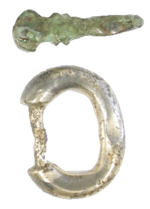Hi all. For those who haven’t met me yet, I’m Owen. I joined the REMADE project in April (has it only been 6 months?), taking over from Philippa in the artefact specialist role. There is a profile on the REMADE website by way of introduction, and I look forward to working with you all in the coming months.
It’s been a whirlwind since I joined the project. I’ve sat through discussions about elements on the fringes of the periodic table that I never knew existed. Its been a steep learning curve getting my head around the brave new world of chemical analysis, but I’m settling into it. With Phillipa the team got a running start on coins, and that work has continued. Since I joined we’ve also made our first major strides into the world of small finds. In the last few months we’ve analysed over 2,500 objects from a range of sites, including:
- The A14 Cambridgeshire-Huntingdon (Iron Age and Roman, MOLA-Headland Infrastructure).
- Beedon, Berkshire (Iron Age and Roman, Lindsey Bedford).
- Bishopstone, Kent (Roman and early Saxon, Martin Bell).
- Bloomberg, London (Iron Age and Roman, MOLA).
- Fishbourne Palace (Iron Age and Roman, Sussex Past).
- Silchester Forum Basilica and Insula IX (Iron Age and Roman, Mike Fulford/UoR).
- Vindolanda (Roman, Vindolanda Trust).
 Analysis work on these is ongoing, and I hope to start sharing interim reports soon. These sites have already completely revolutionised our understanding of major categories of object, especially in the Early Roman period. We’ve been able to identify strong patterns in craft practice, which we’re keen to discuss with you to translate into stories about different social groups and individuals. Some of the clearest patterns so far link the small finds very strongly to previous work on coins. An early Saxon buckle tongue from Bishopstone has the composition of a Roman coin, suggesting that an antique coin was melted down specially. This alloy was not used for the buckle frame, which was instead tinned. This would have produced a striking gold/silver colour contrast. At Bloomberg, almost all of the brass had high levels of zinc (c 17-25%). This is what we would expect for the early Roman period, and is the same as that found in contemporary sestertii and dupondii. The lorica squamata scales, however, had a uniformly-low 8-10% zinc; the same as that seen in contemporary semis and quadrans coins. No previous studies have identified military equipment made of this material, and it is notable that these coins are not common in Britain.
Analysis work on these is ongoing, and I hope to start sharing interim reports soon. These sites have already completely revolutionised our understanding of major categories of object, especially in the Early Roman period. We’ve been able to identify strong patterns in craft practice, which we’re keen to discuss with you to translate into stories about different social groups and individuals. Some of the clearest patterns so far link the small finds very strongly to previous work on coins. An early Saxon buckle tongue from Bishopstone has the composition of a Roman coin, suggesting that an antique coin was melted down specially. This alloy was not used for the buckle frame, which was instead tinned. This would have produced a striking gold/silver colour contrast. At Bloomberg, almost all of the brass had high levels of zinc (c 17-25%). This is what we would expect for the early Roman period, and is the same as that found in contemporary sestertii and dupondii. The lorica squamata scales, however, had a uniformly-low 8-10% zinc; the same as that seen in contemporary semis and quadrans coins. No previous studies have identified military equipment made of this material, and it is notable that these coins are not common in Britain.

These objects present so many avenues for study, but that brings with it new challenges. Working with Kathryn we’ve made changes to the database to account for the complexities of multi-part objects, and record different decorative techniques and art styles. We’ve also refined our sampling methods even more, increasing our sampling speed whilst reducing the intrusivity of the process, and allowing smaller pieces to be used (these innovations largely emerged due to the challenge of sampling individual strands of a cable-twist bracelet fragment that were visibly different in colour!).
I’m very keen to continue this exploration through more collections, as we start to move further out of the early Roman period and southern England.

